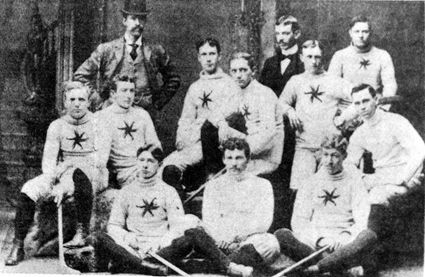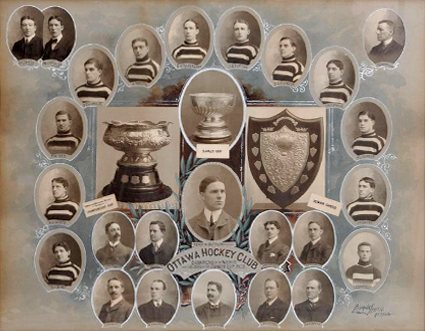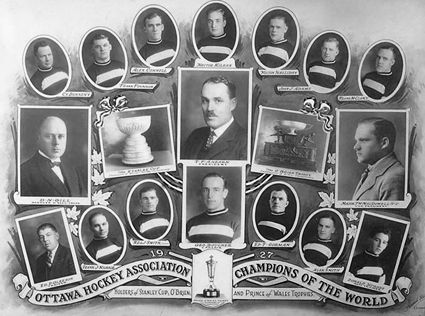The original Ottawa Senators were founded back in 1883 as an amateur club, later becoming a professional team. In the early years of hockey the club moved from league to league as the organization of early hockey was still finding it's feet.
Aside from the changes in leagues, the club also took some time to settle on a permanent nickname as well. Known as the Generals in the 1890's, the club was known as the Silver Seven from 1903 to 1907 before adopting the name Senators starting in 1912.
The 1885 Ottawa Hockey Club
One of the most successful teams in the early days of hockey, the club won their first Stanley Cup in 1903 when they defeated the Montreal Victorias in a two-game, total goals series. Game 1 finished in a 1-1 tie, but Ottawa roared to life and dominated the second game 8-0 led by Frank McGee's hat trick and two goals each by Dave Gilmour and Suddy Gilmour plus a single goal by Bill Gilmour. As a result of their 9-1 triumph, Ottawa became league champions were
declared holders of the cup for the first time in club history.
Two days later the new champions were challenged for their new
trophy by the Rat Portage Thistles in a best-of-three series. Game 1
went to Ottawa 6-2, with McGee scoring twice. Two days later, Ottawa
successfully defended their trophy with a 4-2 win, with McGee scoring
twice more, including the cup winning goal at 8:20 of the first half, as
the game had yet to be divided into three periods. As a reward for
their victory, each member of the squad would receive a silver nugget,
which gave birth to the team's new nickname - The Silver Seven.
The Stanley Cup champion 1903 Ottawa Hockey Club
Before the 1904 CAHL season began, Ottawa
faced another challenge for the Stanley Cup, this from the Winnipeg
Rowing Club. A best-of-three series, play began on December 30th, 1903.
When the series concluded on January 4, 1904, the Silver Seven prevailed
after a 9-1 win, a 6-2 loss and a 2-0 shutout in Game 3.
Ottawa
had a tumultuous 1904 season, as they withdrew from the CAHL after only
four games and joined the new Federal Amateur Hockey League but did
not participate in any of the FAHL regular season games.
After
leaving the CAHL, the Silver Seven would face a cup challenge from the
Toronto Marlboros, who they turned away 2 games to none in their
best-of-three challenge in late February of 1904.
Once
the FAHL regular season was concluded, it's regular season champions,
the Montreal Wanderers met the Silver Seven to compete in a two-game,
total-goal series for the FAHL championship and the rights to the
Stanley Cup that went with it. At least that was the plan. The first
game ended in a 5-5 tie when the Wanderers refused to play overtime with
the same referee in charge and then had the temerity to demand the
series begin anew as a best-of-three! When the trustees of the cup
ordered the series to continue as planned, the Wanderers abandoned their
challenge, leaving the Silver Seven as FAHL champions despite their
having played but a single tie game in league competition!
A
final challenge to Ottawa was arranged for one week later, this from
Brandon Wheat Cities in another best-of-three format, which the Silver
Seven turned away with a pair of victories. While McGee had only played
in four regular season games during the 1904 season, he skated in eight
cup challenge games, scoring 21 times as the Silver Seven turned away no
less than four separate challengers.
In
their first full season of FAHL competition in 1905, Ottawa came first
with a 7-1 record as McGee would tie for the league lead with 17 goals. The highlight of McGee's regular season would be a five goal performance on February 4th.
During
the season, the Dawson City Nuggets would travel 4,000 miles from the
Yukon to challenge Ottawa. Their trip would take a month to complete and
include traveling on foot, by sled dog, automobile, ship and train.
Game 1 of the best-of-three would go to Ottawa by a score of 9-2. Game 2 would be one for the
ages, as Ottawa continued to pile up goals at a furious pace, eventually
winning by an unfathomable 23-2 final score with McGee setting a record
which still stands today, as he scored an incredible 14 times! Eight of
McGee's goals were consecutive and came in under nine minutes of
playing time.
As league
champions, Ottawa retained the cup and was challenged once again by the
Rat Portage Thistles. Game 1 was won by the
Thistles 9-3 but Ottawa retained the cup by winning Games 2 and 3 by scores of 4-2 and 5-4.
The Stanley Cup champion 1905 Ottawa Silver Seven
For
the 1906 season, the Silver Seven moved to the new Eastern Canada
Amateur Hockey Association. They tied for the best record at 9-1.
Ottawa
would face two challenges during the regular season, first from Queen's
University in a best-of-three. After Game 1 went the way of the Silver
Seven 16-7, there was little doubt that the cup would remain with the Silver Seven,
which was confirmed by a 12-7 score in Game 2.
Just prior to the end
of the regular season, Ottawa again had to face a cup challenge, this
time from Smiths Falls in another best-of-three series. Ottawa had little
trouble defending it's now three year grip on the Stanley Cup, as they
won two straight by scores of 6-5 and 8-2. In all, McGee scored 15 times
in the four cup challenge games that season.
The ECAHA playoffs took place on March
14th and 17th, 1906. The series was a two-game, total-goal affair. The
Montreal Wanderers put in an early claim on the cup with a resounding
9-1 win in the first game.
Ottawa
was down, but not out, as they entered Game 2, but 12 minutes in,
Montreal scored again to increase their lead to nine goals. McGee got
Ottawa on the board in the first half and again before the half ended to
help cut the margin to 10-4. The Silver Seven would come out flying in
the second half, and score six consecutive goals to even the series at
10-10! In the final seven minutes of the contest, Lester Patrick
would score to put Montreal in front and then end the three year reign
of the Silver Seven with an empty net goal in the final seconds.
The club would regain the Stanley Cup in March of 1909 when they won the ECHA regular season championship, taking control of the trophy from the Wanderers. In January of 1910, the team would turn back challenges from the Galt Hockey Club 15-4 in a two-game, total goals series and then the Edmonton Hockey Club 21-11 in another two-game, total goals series.
The team joined the National Hockey Association, in 1910 and regained the Stanley Cup again as the 1911 NHA champions, once more relieving the rival Wanderers of the cup. Three days later they again turned back a challenge from Galt HC 7-4 and and another three days later the Port Arthur Bearcats were thrashed 13-4, with both contests being single elimination games for the rights to the cup, their last as the Silver Seven and their last of the cup's "challenge era".
The 1911 Ottawa Silver Seven posing with their Stanley Cup
After the NHA dissolved, the Ottawa Senators joined the brand new National Hockey League as a charter member in 1917. They soon rose to prominence, capturing four more Stanley Cups, with the first being in 1920 over the Seattle Metropolitans 3 games to 2, they retained the cup in 1921 over the Vancouver Millionaires 3 games to 2, and again in 1923 over the Edmonton Eskimos 2 games to none during the era from 1915 to 1922 when the NHL champion would take on the champion of the Pacific Coast Hockey League and later from 1923 to 1926 the Western Canada Hockey League.
The 1919-20 Ottawa Senators
After winning the championship in 1927, which by now saw the cup in the sole possession of the NHL, by defeating the Boston Bruins by virtue of 2 wins and 2 ties, the Senators began a decline in fortunes, primarily due to the small size of Ottawa when compared to the other cities in the league at the time.
The Stanley Cup champion 1926-27 Ottawa Senators
Ottawa's population in 1931 was 110,000, one-fifth the size of Toronto, which was the second smallest NHL city at the time. They began to sell off their best players, suffered from low attendance at home against new expansion teams, such as the Boston Bruins, Chicago Black Hawks, Detroit Cougars, New York Americans, New York Rangers and the Pittsburgh Pirates, as well as the higher travel costs to play those same teams all of which were located in the United States.
The Great Depression also affected the team and caused the sale of even more players, including King Clancy to Toronto. Things got so bad that the team suspended operations for the 1931-32 season and returned to finish with the worst record in the league two years in a row in 1932-33 and 1933-34. with their final game coming on this date in 1934, a 2-2 tie against the Montreal Maroons.
The owner of the franchise then announced that it would not return to Ottawa for the 1934-35 season due to losses of over $60,000 since resuming play and that he would be relocating the team to St. Louis for the 1934-35 season.
The renamed Eagles fared little better financially in St. Louis however, with long, expensive train trips to New York and Boston as well as a large number of games against Montreal and Toronto, as the poor Eagles were forced to take Ottawa's place in the Canadian Division of the NHL, despite being located much closer to Chicago and Detroit of the American Division.
The club finished with a dismal record of 11-31-6 for last in the league, and after just one season, the owners of the franchise sold the club back to the NHL for $40,000 and the players were then sold off to the remaining eight clubs in the league, bringing an end to one of the mightiest franchises of hockey's formative years.
It would be 58 years before the league would come back to Ottawa in 1992 with the new incarnation of the Senators.
Today's featured jersey is a 1927-28 Ottawa Senators Frank Nighbor jersey. Back in the early days of professional hockey, the Senators made it a
habit of celebrating their status as World's Champions by wearing a
commemorative patch on their jerseys the following season, as was the
case in 1921-22, 1923-24 and 1927-28.
The Senators trademark red, black
and white horizontal "barberpole" stripes were first adopted in 1903,
and except for one season with vertical stripes in 1910-11, remained in
use through the original Senators final season in Ottawa of 1933-34,
with the addition of the letter "O" crest from 1929-30 on.
Nighbor signed with Ottawa for the 1915-16 season and immediately led the team in scoring his first season and the entire NHA in his second. He won a Stanley Cup with the Senators in both 1920, 1921, 1923 and1927.
He was named the first recipient of the
Hart Trophy as the NHL's Most Valuable Player and also the first to be awarded the
Lady Byng Trophy by
Lady Byng herself in a surprise presentation in 1925 and won it again in 1926. He was one of the players sold during the Senators financial decline, having been sent to the Toronto Maple Leafs during the 1929-30 season and was elected to the Hockey Hall of Fame in 1947.
Today's video section is a brief recap of the original Senators history and how it influenced the branding of the newly reborn Senators.


















No comments:
Post a Comment
We welcome and encourage genuine comments and corrections from our readers. Please no spam. It will not be approved and never seen.